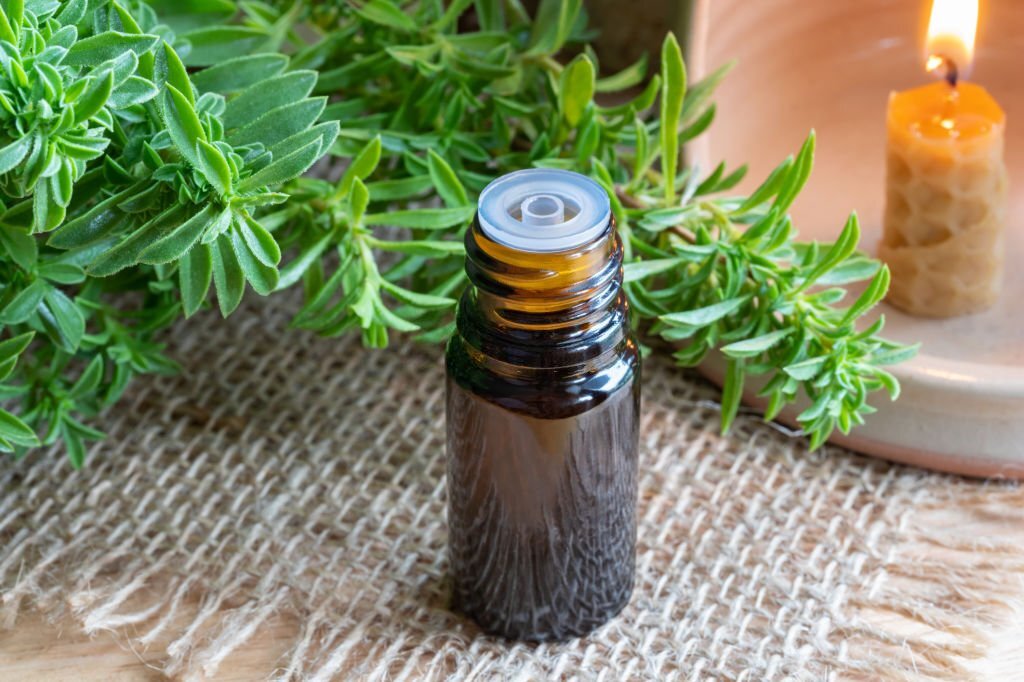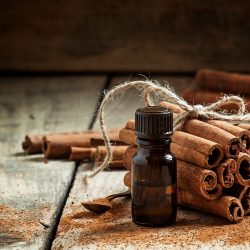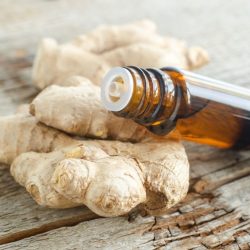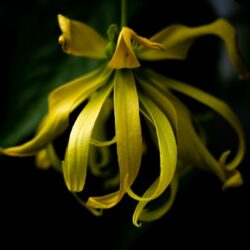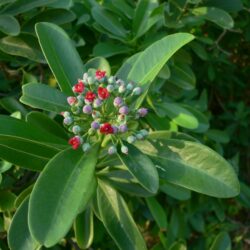Mountain savory, whose botanical name is Satureja montana, belongs to the Lamiaceae family. Its essential oil is extracted from the flowering branches.
History of Savory
Wild, perennial mountain savory, and savories in general, have been known and/or cultivated since ancient times, particularly in Italy. Savory’s reputation as an aphrodisiac dates back to antiquity, when the Romans made great use of it during their “orgiastic” meals, for its dual properties of aiding digestion of “heavy” foods and stimulating sexuality.
In European folk medicine, it is still reputed to treat male sexual dysfunction.
In ancient times
Savory’s reputation dates back to antiquity. The Romans once made great use of it at their orgiastic feasts, for its ability to aid digestion after copious meals and to stimulate the erotic instinct. In Greek mythology, it was nicknamed“The herb of happiness” because it was given to the satyr Anos by Dionysus. Lacking sexual vigour, Anos lamented his lack of popularity with the goddesses of Mount Olympus. Dionysus, who did not wish to see the satyr’s profession dishonoured, offered him mountain savory.
It was also highly appreciated by the Romans and Greeks, who long before the advent of pepper and chilli were using it as one of the spiciest condiments in cooking. At the beginning of our era, Greek doctors and botanists(Dioscorides, Galen) recognised savoury for its medicinal properties.
Before the plant was described by the Latin naturalist Pliny the Elder and the Greek physician Dioscorides, both contemporaries of the emperor Nero , archaeologists had found savory in several tombs dating back to the Pharaonic era. Far less than an aphrodisiac, the Egyptians must certainly have considered it a useful ingredient in embalming techniques. Savoury was used to correct pheasant game because of its anti-toxic and anti-putrid properties. This is why the Egyptians used it to embalm corpses.
Latin poets(Virgil, Ovid, Martial) sang the praises of savory. Here are a few verses by Marcus Valerius Martialis (43 – 104), who lends these words to the muse Erato. This muse of erotic poetry does not go easy on the allegedly infamous Lupercus.
“For a long time, Lupercus, your chin has been without strength. And yet, like a fool, you do everything in your power to restore its vigour. But the rockets, the aphrodisiac bulbs, the stimulating savory are of no help to you. You’ve started to bribe pure mouths with money. Nor does it awaken any lustful sensations in you. Is it not astonishing, quite incredible, that it has cost you so much, Lupercus, to remain impotent?”
In the wake of the Roman legions, savory made its appearance in Gaul, in regions where it did not grow spontaneously. Pliny himself referred to it as a condiment and medicinal plant: “Savory is a diuretic and a wonderful aid to digestion, as well as stimulating the appetite if taken with a drink on an empty stomach”.
If you take an infusion of savory at the end of a hearty meal, it’s not just for the pleasure of the senses. Above all, savory makes digestion easier. That’s why it was used in ancient times as a condiment to flavour vegetables, sauces and grilled meats.
So it’s not just a question of fragrance, let alone taste (savoury, like its lamiaceous friends, is not just a vulgar flavour enhancer…). So it’s not for nothing that this plant has enjoyed great prestige since Antiquity, alongside thyme, wild thyme and hyssop. But the ancients, far more than we are capable of doing, knew how to combine the medicinal and culinary properties of most plants.
Savory was used as a condiment in Roman orgies and was brought to Europe by Benedictine monks in the High Middle Ages, although its cultivation was banned in a number of monasteries because of its reputation as an aphrodisiac plant. In fact, its Latin name, satureia, may come from the word “satyr”… In any case, that’s what it’s been called for at least twelve centuries, and it’s under that name that it’s listed in the famous Capitulary of Villis. And its reputation as an aphrodisiac is nothing new either, as the Latin poet Ovid already refers to it in Book II of The Art of Love: “Savory stirs up the fires of love violently, its name coming from the satyrs whose ardour for amorous exploits is well known”.
Dioscorides and later Paul of Aegina (7th century AD) recognised its qualities as being similar to thyme (they even distinguished mountain savory from garden savory). That said, it wasn’t really until the Middle Ages that savory made its way into the heart of pharmacies. In the 11th century, Macer Floridus noted savory’s “great power of heat” and described it admirably, listing a number of its major properties: diuretic, expectorant, antidiarrhoeal, emmenagogue, aphrodisiac and antiletargic.
In the Middle Ages
During this period, it was excluded from pharmacology because of its aphrodisiac properties and was considered a devil’s plant. However, it was given a new lease of life by the Benedictine nun Hildegarde, who praised its stimulating and digestive properties in her medical treatise Causae et Curae. Hildegarde attributed stimulating, tonic, antispasmodic, stomachic and antirheumatic qualities to her Satereia. “More hot than cold”, she said, and she also prescribed it for the pain of gout. At the beginning of the sixteenth century, Culpeper recommended this plant for pregnant women whose digestive problems could be caused by eating too much. A little later (1552 ),Jérôme Bock wrote that “this plant is so good for the stomach that it is called ‘sauce aux pauvres gens’ (sauce for the poor); the Germans mix it with cabbage, which they cook in salt and vinegar to preserve it for a long time”.
It is one of the plants recommended for cultivation on royal estates by Charlemagne in the Capitular De Villis (late 8th or early 9th century). The people of Provence, in whose cuisine it has become indispensable, call it “donkey pepper”. Later, it was used to make the famous ” eau d’Arquebusade “, a popular remedy in folk medicine.
By the end of the reign of the Emperor Charlemagne (748-814), savory must have been of considerable importance, since it appears – under the name satureiam – in the list of 94 plants that the Carolingian ordered to be grown in the kitchen gardens of his estates and monasteries. (This famous chapter, of uncertain date, is known as“De villis vel curtis imperiabilis“. It is regarded today as a sort of hit parade of medieval plants)
Among the classic sources of botanical history, savory is mentioned in a famous work entitled De viribus herbarum. The author is Macer Floridus, a mysterious figure whom some identify with Aemilius Macer, a Latin didactic poet who lived in the first century BC, others with Bishop Odo de Meung, or an anonymous monk from Monte Cassino, or even a learned herbalist from the Salerno School of Medicine in the Middle Ages.
In the end, it doesn’t matter who was hiding behind the pseudonym of Macer Floridus. Here are the lines attributed to him about savory:
“Savory, which the Greeks call θύμβρα is a little drying, but has a great power of heat. Taken with wine, it is diuretic, emmenagogue, facilitates the expulsion of the dead foetus in the womb, and precipitates the rear faix. Reduced to a powder and cooked with honey, it becomes a food that causes phlegm to be expectorated. It has the same virtue when drunk in wine. Taken in large quantities with warm wine, it soothes colic, as I have often found.
There is a disease called lethargy, which doctors regard as the opposite of frenzy, in that the latter keeps the patient perpetually sleepless, while the former plunges him into a deep sleep. Savory, mixed with vinegar, is an excellent remedy against such disastrous numbness: simply rub it repeatedly over the head of the person affected.
Pregnant women should be careful not to touch this herb, as not only ingestion but also contact with it can cause abortion. Crushed and mixed with a little wine, it soothes nausea. It produces the same effect when eaten in an egg. Fresh or dried, and converted into a beverage, it is considered an aphrodisiac: mixed with wine, honey and pepper, it inflames the senses with immoderate ardour. This is why it is called “satureia” in Latin, because satyrs are very lustful. In the absence of thyme, doctors recommend savory, because the two plants have the same potency”
From the Renaissance to the present day
In 1765, the German physician Cartheuser stated that savory was capable of “admirably increasing and provoking excretions of all kinds. It is therefore not the least antiscorbutic, diuretic, lithontriptic, carminative, stomachic, pectoral, uterine and aphrodisiac”.
After a very long period of oblivion, it was briefly discovered by Henri Leclerc in the 20th century, and more widely by Jean Valnet. It was he who reported what is contained in the following lines.
In 1975, researchers at the Faculty of Montpellier published a document entitled ” Place de l’essence de satureia montana dans l’arsenal thérapeutique “. The aim of this study was to highlight and compare the antibacterial and antifungal actions of a number of essential oils, including savory and thyme, on a range of staphylococci, fungi and other infectious germs.
The results showed that savory was clearly superior to the other essences used. What’s more, it acted at concentrations 2 to 20 times lower than the other essences. In only one case was thyme essential oil more effective than savory. Valnet said: “Savory essential oil therefore has an antimicrobial and antifungal action that is clearly superior to those of the labiate essences commonly used in therapeutics”
Dr Valnet (20th century) recommended it for indigestion, abdominal pain, mental and sexual weakness, insect bites and wounds. Didn’t Cazin say that “this plant, which has fallen into disuse as far as its medical use is concerned, no doubt because of its use in the culinary arts, has properties from which we can benefit”?
Did you know?
When crumpled, savory leaves and flowers emit a peppery, pungent odour, indicating that these parts of the plant contain its aromatic essence. Its nicknames “poivrette” and “poivre d’âne”(pêbre d’ai, pébré d’aï in Provençal) are a reminder of this particularity.
Did you know that it is used in cooking? It is one of the best seasonings for pheasant game. It can be used as part of a bouquet garni to flavour cooked dishes, especially meat-based ones (civets, etc.). Aromatic plants should not be relegated to the rank of common aromatics. The term ‘aromatic’ is deceptively restrictive in at least two respects:
- Any plant is aromatic if it gives off an aroma. Linden is aromatic. So is strawberry, and so is geranium. The term ‘aromatic’ cannot therefore be reduced to sage, thyme, wild thyme, bay leaves, marjoram, oregano, lavender, hyssop, etc
- Aromatics are synonymous with aroma, smell and perfume. As well as their ability to give off a scent, aromatic plants do much more than simply satisfy our olfactory cells and taste buds. It would be wrong to think so.
So there are very close links between condiment plants on the one hand and medicinal plants on the other. But all this is purely human. The widespread adoption of certain practices often wrongly suggests that aromatic plants commonly used in cooking, such as savoury or parsley, do not have beneficial properties in other areas. This is, of course, not true.
What are the pharmacological properties of essential oil of mountain savory flowering branches?
Antibacterial effect :
Mountain savory essential oil is a major anti-infective by disrupting the bacterial membrane. It is particularly effective on the lower part of the body:
- Genito-urinary infections
- Gastrointestinal infection
Its antibacterial effect has been demonstrated againstEscherichia coli, Salmonella typhimurium, Staphylococcus aureus, Klebsiella pneumoniae and Streptococcus pyogenes. In fact, it is an anti-infectious plant against Gram-positive(Staphylococcus aureus) and Gram-negative(Pseudomonas aeruginosa) bacteria that are resistant to antibiotics and responsible for hospital-acquired illnesses.
It is also anti-parasitic.
Antifungal effect :
Studies have demonstrated its effectiveness against fungi associated with skin diseases, candidiasis and aspergillosis.
Anti-oxidant effect:
This effect has been demonstrated in vivo against hydrogen peroxide. Savory essential oil is therefore useful for preserving cold meats.
Other effects:
- Regulates peristalsis
- Destroys pathogenic flora while preserving saprophytic flora (powerful toxin catcher and good drainer)
- Immunostimulant
- Hyperthermic
- Hypertensive
- Anti-asthenic tonic
- Active on the ANS Ʃ
- Endocrine action (progesterone and adrenal)
- Aphrodisiac
- Cortison-like
- Percutaneous analgesic useful for localised pain
- Slightly antidepressant
- Stimulates digestive secretions
Does Mountain Savory essential oil require any precautions for use?
- Highly dermocaustic and revulsive in its pure state, high dilution required
- Caution in cases of hepatic insufficiency per os (hepatotoxic)
- Caution in case of gastritis and ulcer per os
- Risk of oesophagitis or gastritis per os
- Do not use as a fumigant
- Do not diffuse, inhale or use in the bath
- For adults only
- Do not use in high doses or for long periods of time
- Not recommended for pregnant or breast-feeding women
- Do not combine with cortisone, risk of drug interaction
- Do not use for more than 10 days
- Drug interactions with essential oils containing more than 10% sesquiterpenes
- Hepatic metabolism may cause hepatotoxicity over long periods or at high doses. It should always be diluted and combined with other well-tolerated essential oils, in order to “cut” it and reduce its proportion in the final mixture
- Not for use on animals
- Avoid combining with anticoagulants
- Avoid high doses
Medical literature and clinical trials:
- Dilek Azaz, Fatih Demirci, Fatih Satıl, Mine Kürkc ̧üog ̆lu, Kemal Hüsnü Car Baser. Antimicrobial Activity of Some Satureja Essential Oils. Z. Naturforsch. 2002
- Nada Bezi, Mirjana Sko^Ibu, Valerija Dunki. Phytochemical composition and antimicrobial activity of Satureja montana L. and Satureja cuneifolia Ten. essential oils. Acta Bot. Croat, 2005
- Kundaković T, Stanojković T, Kolundzija B, Marković S, Sukilović B, Milenković M, Lakusić B. Cytotoxicity and antimicrobial activity of the essential oil car from Satureja montana subsp. pisidica (Lamiceae). Nat Prod Commun. 2014
- Güllüce M, Sökmen M, Daferera D, Ağar G, Ozkan H, Kartal N, Polissiou M, Sökmen A, Sahin F. In vitro antibacterial, antifungal, and antioxidant activities of the essential oil and methanol extracts of herbal parts and callus cultures of Satureja hortensis L. J Car Agric Food Chem. 2003
- Tatjana Mihajilov-Krstev, Dragan Radnović, DušAnka Kitić, Zorica Stojanović-Radić, Bojan Zlatković. Antimicrobial activity of Satureja hortensis l. Essential oil car against pathogenic microbial strains. Arch. Biol. Sci, Belgrade, 2010
- Gaysinsky S, Davidson P, Bruce D, Weiss J. Growth inhibition of Escherichia coli O157:H7 and Listeria monocytogenes by car vacrol and eugenol encapsulated in surfactant micelles. J Food Prot. 2005
- Ultee A, Bennik M, Moezelaar R. The phenolic hydroxyl group of car vacrol is essential for action against the food-borne pathogen Bacillus cereus. Appl Environ Microbiol. 2002
- Ultee A, Kets W, Smid E. Mechanisms of action of car vacrol on the food-borne pathogen Bacillus cereus. Appl Environ Microbiol. 1999
- Mounia Oussalah, Stéphane Caillet, Linda Saucier, Monique Lacroix. Inhibitory effects of selected plant essential oils on the growth of four pathogenic bacteria: E. coli O157:H7, Salmonella Typhimurium, Staphylococcus aureus, and Listeria monocytogenes. Food Control, 2007
- Car ramiñana JJ, Rota C, Burillo J, Herrera A. Antibacterial efficiency of Spanish Satureja montana essential oil against Listeria monocytogenes among natural flora in minced pork. J Food Prot. 2008
- Djenane Djamel, Yangüela Javier, Montanes Luis, Djerbal Mouloud, Roncales Pedro. Antimicrobial activity of Pistacia lentiscus and Satureja montana essential oils against Listeria monocytogenes CECT 935 using laboratory media: Efficacy and synergistic potential in minced beef. Food control, 2011
- Oliveira TL, de Araújo Soares R, Ramos EM, das Graças Car doso M, Alves E, Piccoli RH. Antimicrobial activity of Satureja montana L. essential oil against Clostridium perfringens type A inoculated in mortadella-type sausages formulated with different levels of sodium nitrite. Int J Food Microbiol. 2011
- M. Ciani, L. Menghini, F. Mariani, R. Pagiotti, A. Menghini, F. Fatichenti. Antimicrobial properties of essential oil of Satureja montana L. on pathogenic and spoilage yeasts. BIOTECHNOLOGY LETTERS, Volume 22
- Adiguzel A., Ozer H., Kilic H., Cetin B. (2007): Screening of antimicrobial activity of essential oil and methanol extract of Satureja hortensis on car foodborne bacteria and fungi. Czech J. Food Sci
- Radonic A, Milos M. Chemical composition and in vitro evaluation of antioxidant effect of free volatile compounds from Satureja montana L. Free Radic Res. 2003
- Serrano C, Matos O, Teixeira B, Ramos C, Neng N, Nogueira J, Nunes ML, Marques A. Antioxidant and car antimicrobial activity of Satureja montana L. extracts. J Sci Food Agric. 2011

